Back on Track
Object 5: The Nestor of Nordic Exlibris, Otto Wang, Dignifies the Norwegian Exlibris with a Monograph
In 1942 and with much fanfare in the daily press, the Danish exlibris connoisseur and author Otto Wang (a nom de plume for the editor Poul Frost-Hansen), publishes the first monograph dedicated entirely to the Norwegian exlibris.
The book – an octavo brochure printed on thick, heavy paper – has 75 pages, of which the text part takes up seventeen, while the rest are high-quality reproductions of 46 contemporary Norwegian exlibris. All reproductions are made by way of clichés, created by Wendt & Jensens Reproduktionsanstalt, and printed in the esteemed Berlingske Printing House in Copenhagen.
By 1942, Wang had already published thirteen books about exlibris, most focusing on Danish and other Nordic artists and collectors, his most recent work being an overview of the Swedish exlibris, published in 1941.
A Homage to Norway’s Country and People
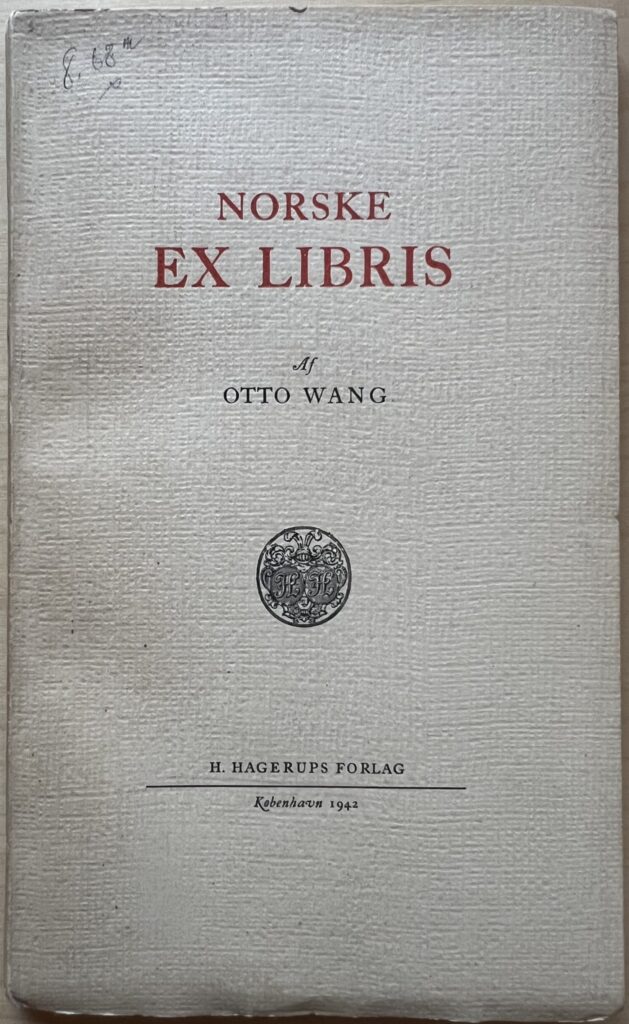
The day before Christmas Eve 1942, Olav Myre, editor of Aftenposten and himself a bibliophile and exlibris collector, dedicates an entire column to the review of Wang’s publication in the Wednesday morning issue of Aftenposten. He introduces Wang’s ‘Boken om norske ex libris’ grandly:
En hyldest til Norges land og folk. – Gerhard Munthe som norsk ex libris-kunsts første og største mester. – En rekke reproduksjoner viser oss moderne norsk ex libris-kunsts stilling i dag.”
“A homange to Norway’s country and people. – Gerhard Munthe as the first and greatest master of Norwegian exlibris art. – A number of reproducations shows us the rank modern Norwegian exlibris art has today.
Wang himself, while putting Gerhard Munthe at the front of the modern Norwegian exlibris movement (“[…] var det i Norge Maleren Gerhard Munthe, der omtrent på samme Tid [1900] skabte en Række norske Ex-L. der blev toneangivende for de kommende Aar.”), favours another artist: Albert Jærn. After blatantly stating that nothing worth mentioning, exlibris-wise, happened between Gerhard Munthe (1849-1929) and Albert Jærn (1893-1949), he singles out Jærn’s exlibris production and quality:
Det er vel nu henimod 25 Aar siden han tog fat. Han har til Dato tegnet langt over 100 Ex. L. Og blant disse findes uten Tvivl det bedste af moderne norske Ex Libris. Tager man hans overordentlig store Produktion i Betragtning, ser man alle disse Ex. L. foran sig (de fleste av dem er samlet i tre, nu udsolgte og antikvarisk ret kostbare Hefter), er der een Ting, der vækker Ens Beundring: hans Evne til at lave noget nyt hver Gang, der er ingen Gentagelser, hans Ex. L. er noget for sig.
What follows is a short, descriptive as well as critical overview of contemporary Norwegian exlibris. These 72 exlibris represent for the expert Wang, the specific Norwegianness – in style, technique, motifs –, of this eclectic art form. They also represent the – in Wang’s opinion – unusual social position of exlibris owners/book collection owners outside of the ‘great families’, nobility and bourgeoise. Wang, who frequently visited Norway during summertime, observed and came to accquiant himself with a unique type of person: outside of the cultural centre(s) Bergen and Oslo, it is especially the commoners, lower-rank public servants, small merchants, servants, young artists and craftspeople that show a strong – inherited or acquired – drive for education, knowledge, and culture while staying humble about it. These people, he writes, often are unexpectedly well-read, far-travelled (to the cultural centres of the European continent) and literate in languages like French, German, and English. And they build book collections and libraries, for which they would want and need exlibris.
When you look at the professions (and the names) of the owners of most of the exlibris in Wangs book, however, the ‘commoner’ is rather… absent.
Who Are the Exlibris Artists?
Whatever we might think about Wang’s motivation and his intentions when he selected and presented these contemporary exlibris, it will be wise remembering the names of the artists.:
- Trygve M. Davidsen (T.M.D.)
- Frøydis Haavardsholm
- Per Kramer (the elder)
- Norman(n/d) Laheld
- Rolf Opsahl
- Axel Revold
- Torleif Rud
- Øyvind Sørensen
- Christian Koren Wiberg
- J. Koren Wiberg
It will be them who are repeatedly mentioned and their exlibris will enter the collections all over Norway. Especially one artist, Albert Jærn, will become the most productive Norwegian exlibris artist of the 20th century. While the popularity of the great decorative artists Gerhard Munthe and Frøydis Haavardsholm will cease after the Occupation and in the atmosphere of the modern, abstract art that became dominant, Jærn kept his production up until his early death in 1949 – we do not know exactly how many exlibris he created, but numbers are estimated between 500–1000.
Exlibris Portfolios
An Unusual Genre
From my albeit limited experience with German exlibris, I was blissfully unaware of the existance and the popularity of the Norwegian exlibris portfolios. Usually called “Ex libris mappe” (Exlibris folder), these were carefully crafted by local printing shops, authorised by the artists, and sold in limited editions to the especially interested. For lack of a better word, I tend to call these “exlibris portfolios” in English: that’s what they – to me – appear to be. A curated overview of selected works by one artist, with or without a short introduction by a known expert in the field. The portfolios were regularly reviewed in the 1930s and 1940s daily press, across the social, political and regional spectrum.
The first I saw of these unsual portfolios were the ones in Nysted Heier’s collection:
- Knut Yran IV (1945)
- Knut Yran: Nye Ex Libris (1944)
- Knut Yran. Med 6 illustrasjoner og et original-exlibris i fargelitografi (1949)
- Syv T. M. D. Ex Libris (1944)
- Jardar Lunde – en norsk kunstner og hans exlibris (1977)
- Ex Libris Hermann Bongard (1943)
Honestly: I thought they were odd. Exlibris glued into a thick paper carton brochure. Hm, that doesn’t lend itself to trading and exchanging exlibris. But I soon became intrigued. I know that I only have half of the original Nysted Heier collection (the other half is lost and I do not know what it contained).
I went looking for similar exlibris portfolios in the Norwegian antiquarian book shops and quickly found a bunch, mainly by exlibris grandmasters Albert Jærn and Henry Schjærven. I decided to purchase a couple and to add them to my collection of Exlibrisiana, complementory to Nysted Heier’s.
Objects 6 and 7: Alb. Jærn, Ex Libris (1942) and Alb. Jærn, Ex Libris (1945)
I have five portfolios, all from the 1940s. We know from the œuvre list Thor Bjørn Schyberg published in 1978 that Jærn published a total of ten, as early as the 1928.
The first portfolio was hand made by Jærn and contained 10 original exlibris. It was crafted in Oslo in 1928 in 20 copies and is considered a rarity: If you have one, consider yourself very lucky!
In the same year, the first printed portfolio with 21 original exlibris was produced in Assens Boktrykkeri in Oslo in 200 numbered copies. If you have enough spending money, you can buy this portfolio together with 20 copies of the exlibris for author Rudolf Nilsen and the original cliché at Bryggen Antikvariat, a specialised antiquarian book store for bibliophiles. Or, you can take a look at the entire portfolio; it is digitised in the collection of the Norwegian National Library in all its glory on nb.no (accessible with a Norwegian IP address–or via a creative workaround).
All of Jærn’s portfolios are well made. Not all survived in that condition to this day. Some of the portfolios have missing exlibris as these were glued into the books and the glue has partially disintegrated. Others shows signs of age and bad storage conditions as they are yellowed, bend, kinked, have rifts or insect damage (and poop).
They do, however, give us an image of the popularity of both Albert Jærn’s exlibris and this type of collector’s edition.
Objects 8, 9 and 10: Henry Schjærven, T.M.D., and Knut Yran
Henry Schjærven
There are other prolific exlibris artists from that time, namely Henry Schjærven, Trygve M. Davidsen and Knut Yran. Of these, the most productive is without a doubt Henry Schjærven. He has an intriguing aestethic and often uses two colors (black/red, black/blue, black/gold) in his many, beautiful and elegant exlibris. Schjærven will be featured with a very special object later, so I will not write much more here. Perhaps only this one observation: Of the portfolios you can still get in the antiquarian book market, chances are high that it will be Henry Schjærven’s. They are beautifully crafted and were produced in limited, but rather high, numbers: between 200 and 500 copies per piece. They all contain original exllibris, glued on sturdy, colored carton. They do suffer, like so many papers from the 1940s and 1950s, from discoloration and acidity which will eventually lead to the paper breaking down completely.
Knut Yran
Not as productive as Jærn and Schjærven, but very much at home in the exlibris genre is Knut Yran. Where Jærn is decorative and has a bit of the mysticism and esotoric design style that was popular in Norway until the 1930s, and Schjærven is elegant, estetically minimalist and tame, Yran is the most expressive – and perhaps the one with the most personal style. Yran uses woodcuts as his favorite printing medium. There are multicolor prints, but most are made with black ink. They are bold, with thick lines and a visible wood structure present. Later on, their format becomes more varied, longer, bigger and with a tendency to show more of the artist than of the owner – a no-go for the ‘true’ exlibris. Yran published portfolios in quick succession, probably riding on the popularity of the genre throughout the 1940s. The three portfolios in the Nysted Heier collection were specially made for the Oslo-based Exlibristene and have handwritten dedications by Yran to Nysted Heier. You can still find some if you browse the antiquarian shops, but they are prone to losing exlibris: often only glued onto thick paper cards, losely gathered in a folded cover.
T.M.D.
A mention on T.M.D.: The illustrator and advertisement creative director Trygve M. Davidsen, early out in the 1940s with exlibris and related materials, has a portfolio, too. I’m not much impressed by T.M.D. (he uses the monogram almost exclusively) exlibris, to be honest. They are not my “style” – nevertheless he is an important figure in the scene. We have a couple of photographic exlibris by him, a new technology which became quite popular in Norwegian exlibris circles. I will talk about this phenomenon at a later point in time.
Object 11: Jardar Lunde – the Last Norwegian Exlibris Portfolio

The small album the size of a postcard contains a couple of exlibris by Northern Norwegian artist Jardar Lunde (1909-1990). Thor Bjørn Schyberg published the portfolio in Klaus Rödel’s publishing outlet “Exlibristen” in Fredrikshavn in 1977. The copy I have is from Nysted Heier’s collection and contains a handwritten dedication from Schyberg to Heier. Lunde entered the world of Norwegian exlibris rather late and I don’t yet know how many exlibris he created.
Next Time: Exlibris!
In the next article, we will – finally – take a look at some exlibris! A bit like Otto Wang did more than 80 years ago, I will show you a collection of Norwgeian Exlibris that I consider to be exemplary. Wang didn’t have many exlibris to chose from: his book is at the beginning of the exlibris craze of the 1940s and many of the most well known and distinct pieces will be created during this time – but after 1942. What was the Norwegian Exlibris in the beginning of the 1940s will become something quite different by the end of it.
Stay tuned for the next part!


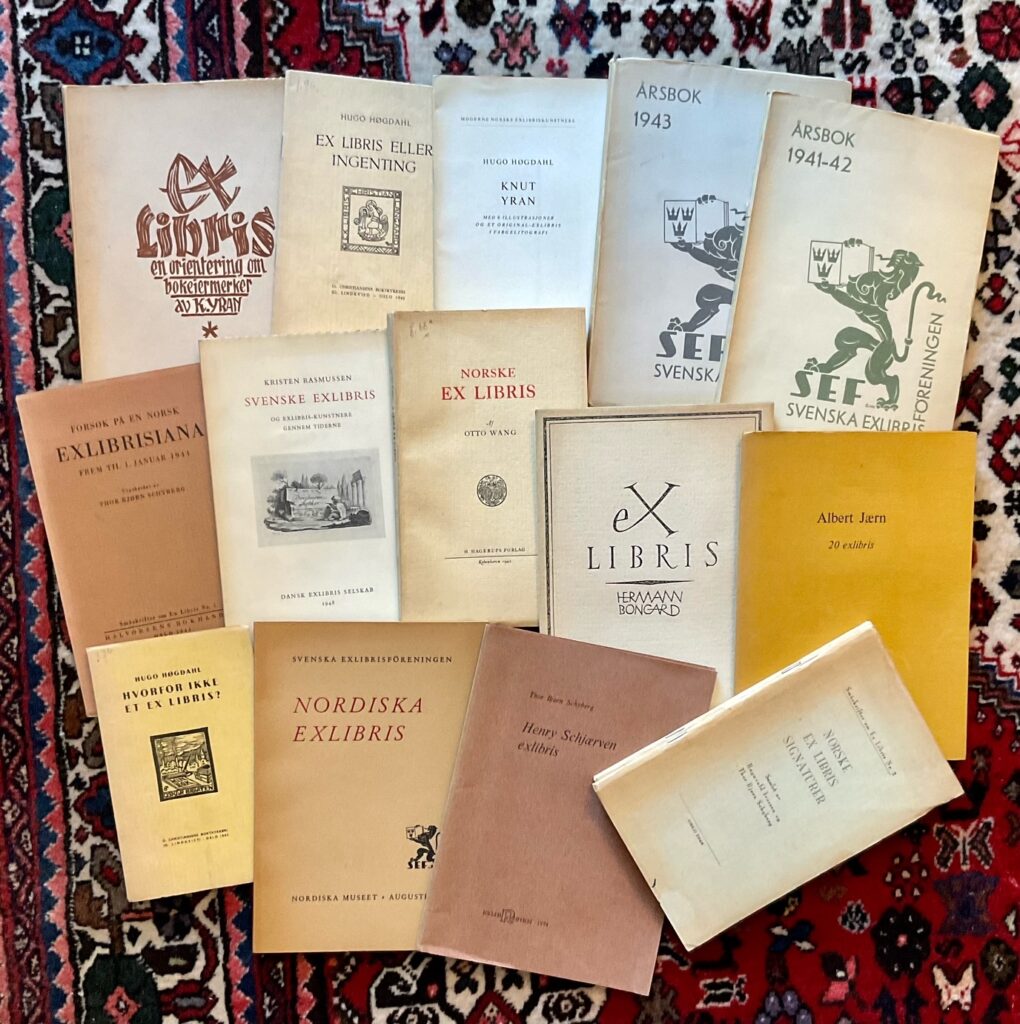
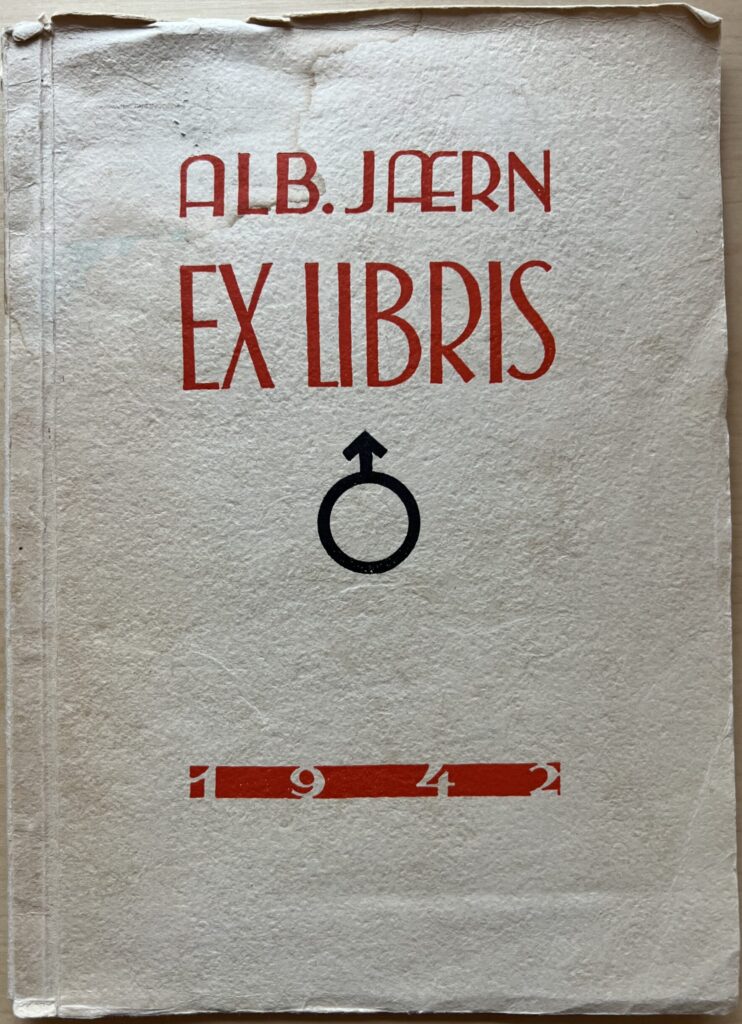
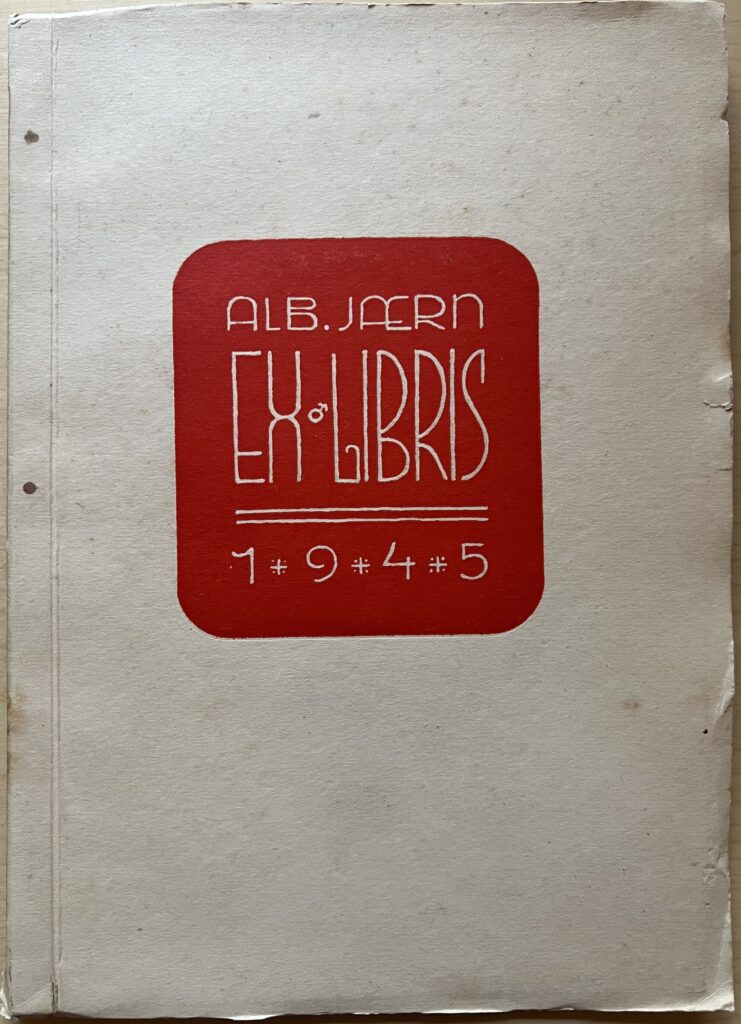

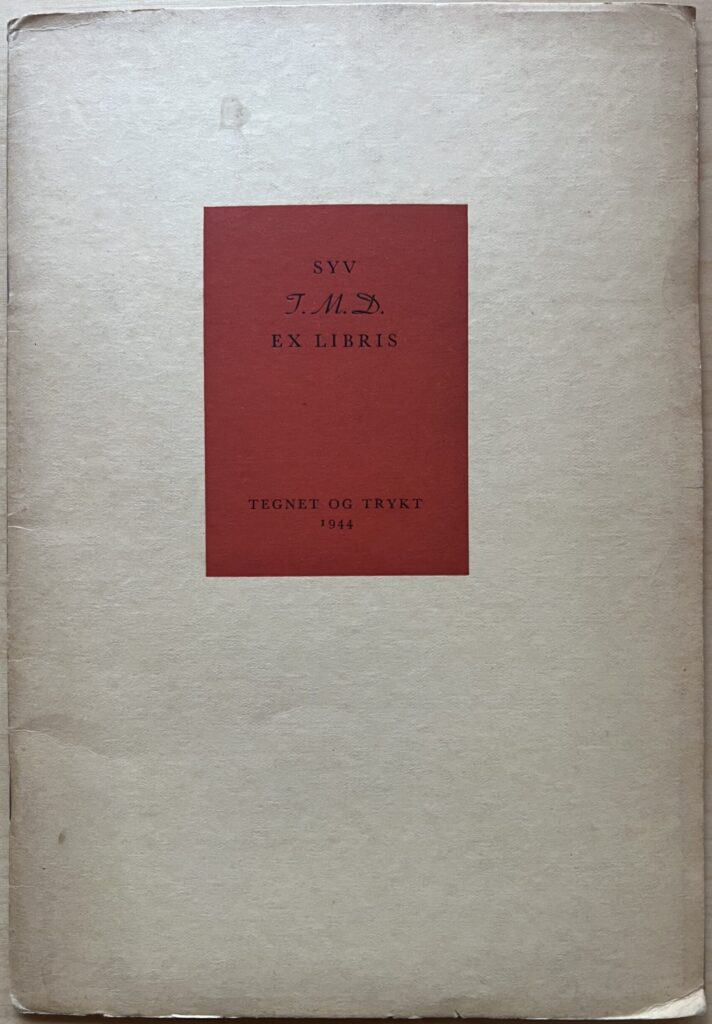
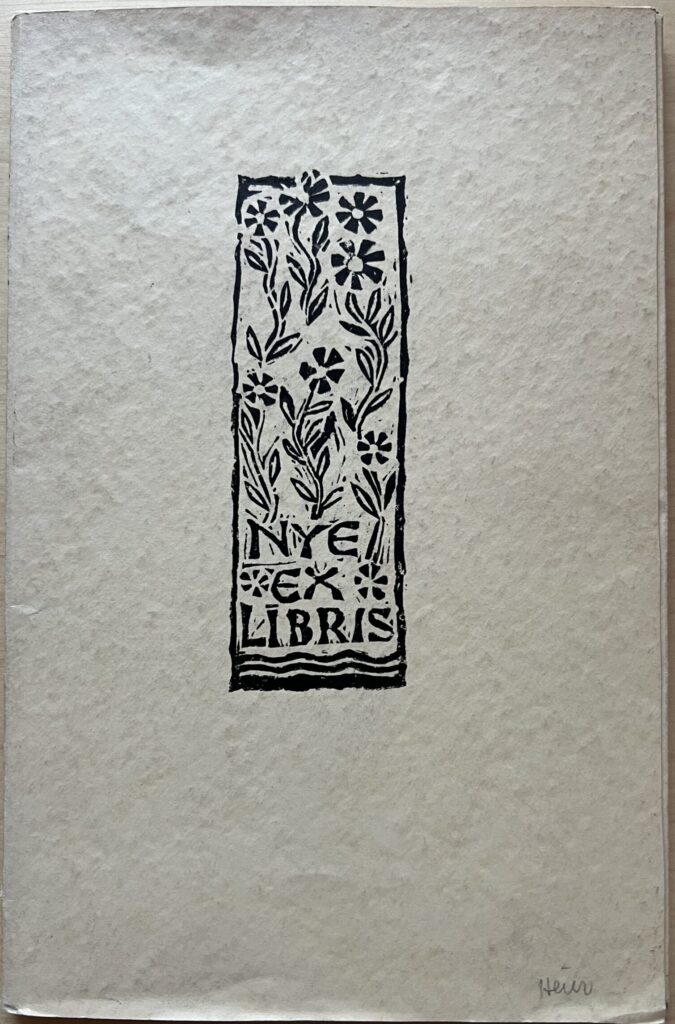
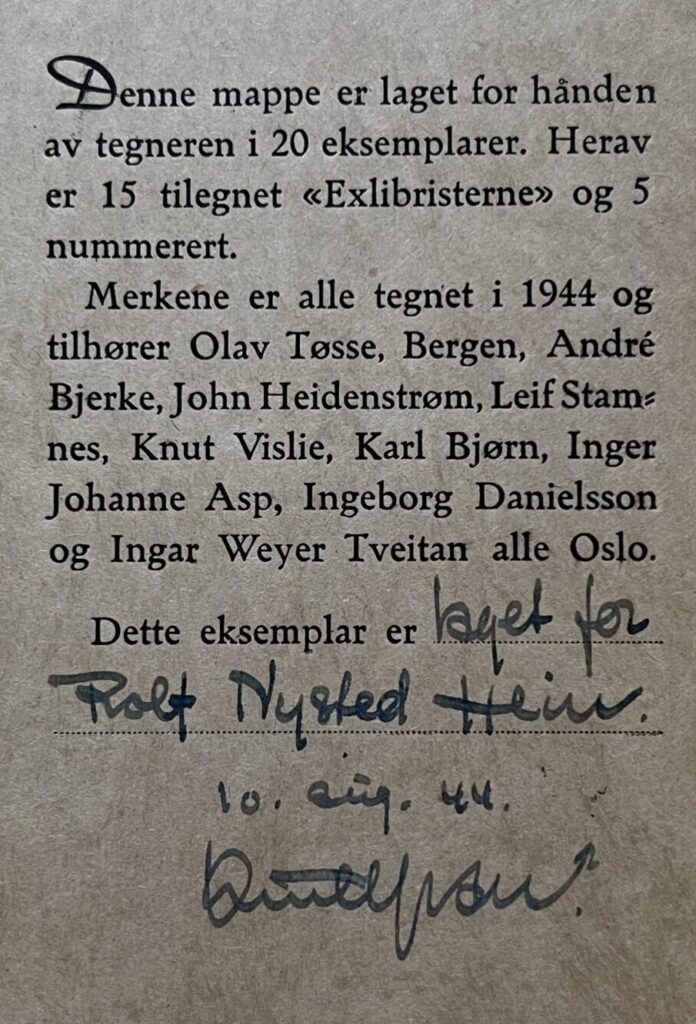

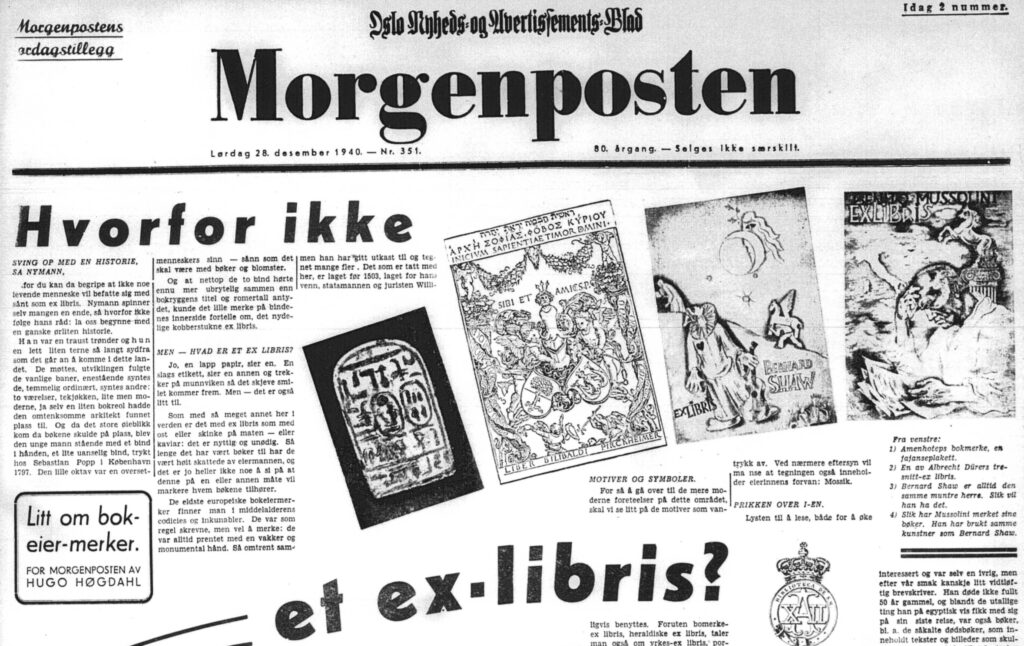
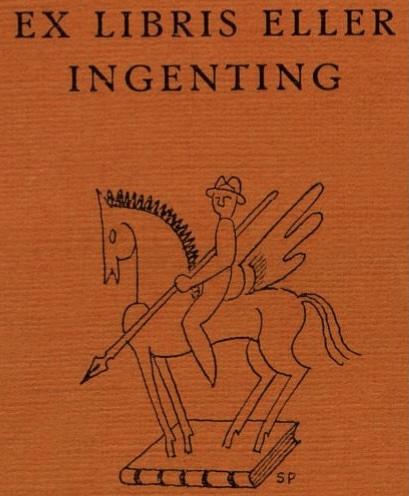
One Comment
Comments are closed.